August is a weird month to bird. As we’ve no doubt mentioned before, we used to just write off August. I mean, most birds have stopped singing. No songbirds are migrating. Oh, and in Montana, hot, smoky weather often sucks the motivation from every pore of our bodies. Over time, however, our “bad August attitude” has, like the current presidential race, suffered a total reversal. Now, Braden and I cautiously look forward to August birding. The only problem? We’re never sure what we’re going to find. (See, for instance, last year’s August post “Birding Treasure at Garnet Ghost Town.”)
This August has been no different, but we began the month with some clear objectives. As Braden’s summer in Montana dwindles ahead of his final year of college, he had accomplished most of his summer birding goals save one: finding a Spruce Grouse. I could relate! After all, I saw my lifer spruce grouse only last year (see our post “Gambling on a Grouse-fecta”). As for me, I too coveted another Spruce Grouse on top of other Year Birds that had so far eluded me. The latter included Olive-sided Flycatchers, and Three-toed and Black-backed Woodpeckers. We both wanted to see migrating shorebirds, but realized it might be a tad early for some of them.
Sadly, Braden and I probably had only one day left to bird together before he departed, so any strategy to accomplish our remaining goals would involve compromise. Nonetheless, we set off last Sunday morning for a place we’d never birded together—Skalkaho Pass east of Hamilton. We got on the road before seven and made a brief stop at Lee Metcalf NWR hoping for shorebirds. No luck, probably because water levels were too high, but we did see a lot of the other usual suspects. Most surprising? Vaux’s Swifts, which I myself had probably never seen at Metcalf before, and at least half a dozen Sandhill Cranes—an unusually high number for that location. “Hm,” we thought, “Maybe some birds are already on the move for their fall migrations!”
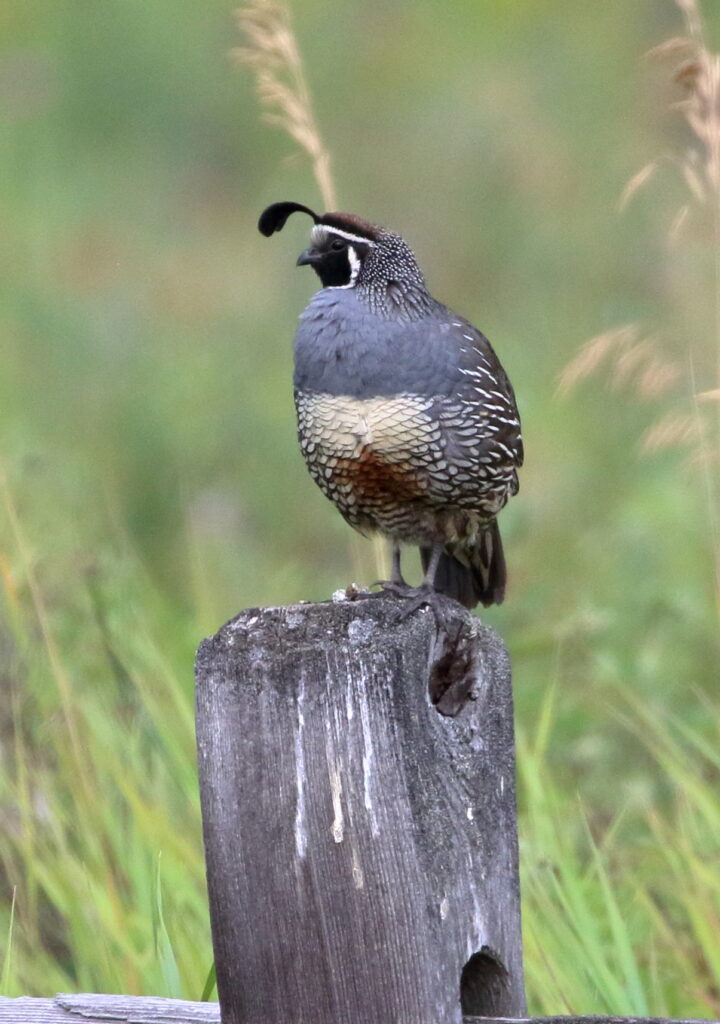
After a quick stop in Hamilton for breakfast sandwiches, we headed toward Skalkaho, the road transitioning from a two-lane road with a painted yellow line, to a “one track” paved road, and finally to dirt. We encountered an early surprise with a herd of bighorn sheep, and then climbed through a gorgeous forest canyon that gave off moist Pacific Northwest vibes and hosted a huge variety of trees. Here, we heard Pacific Wrens and Golden-crowned Kinglets, but our real destination lay high above us.

As the road snaked upward, we entered large burn areas that looked about ten years old. If you’ve been reading this blog (or my book Fire Birds) at all you know that we love to bird in burned forests. Not only do they provide great visibility, standing dead trees attract some of Montana’s most special birds. We pulled over a couple of times to listen for woodpeckers, but didn’t hear anything. Getting out of the car for the third time, however, we were greeted by a loud “Quick! Three Beers!” Braden and I laughed.
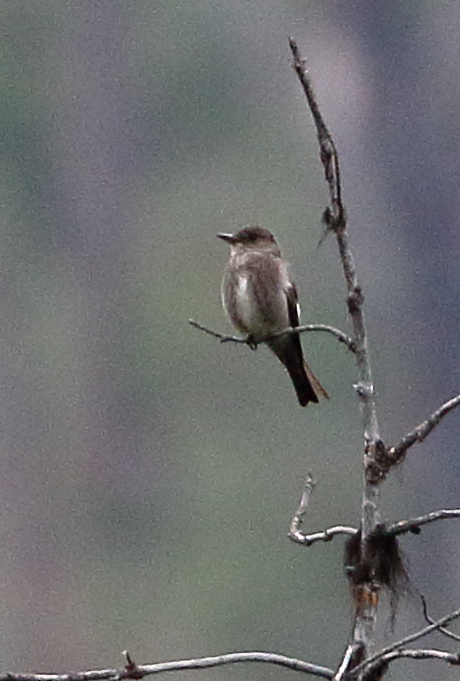
“Olive-sided!” he exclaimed. And not just one, either. We would count at least half a dozen in the next couple of hours.
When we passed 7,000 feet we at last felt we had reached proper Spruce Grouse country. I had located a promising dirt road on the map, but before we reached it, we spotted another dirt road leading to the left. “That looks good,” I told Braden. “Let’s take that.”
“Sounds good,” he answered.
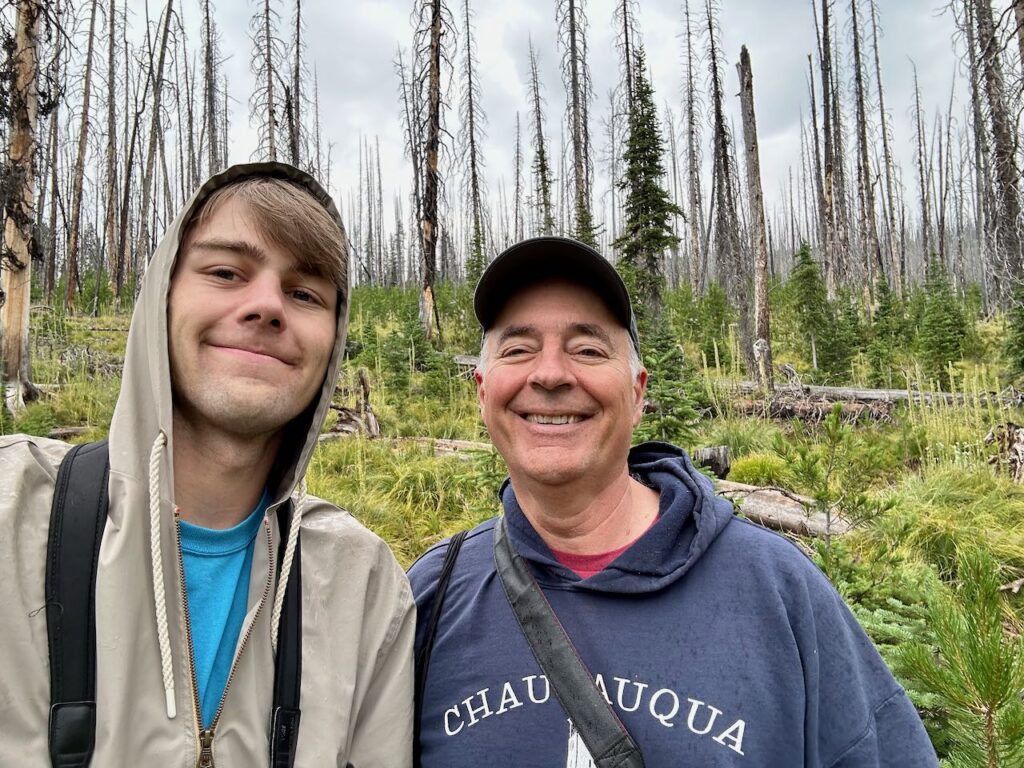
It felt like a good day to find a Spruce Grouse. As on my Spruce Grouse excursion with Braydon Luikart last year, the day was overcast and misty, and I kept expecting to see bevies of grouse sitting in the middle of the road. That didn’t happen. In fact, we drove slowly for about twenty minutes, I keeping my eye on the road while Braden searched trees and openings along the road.
“C’mon, grouse,” I urged them, but it seemed like it might end up being a grouse-less day after all.
Then, Braden said, “Stop! Back up a few feet.”
I obeyed. “There, next to that stump,” he told me. “That definitely looks like a grouse.”
Sure enough, it was a gorgeous female emanating a distinctly Spruce Grouse aura. Just to make sure, I called up my Sibley app and compared it to a female Dusky Grouse. The two looked very different. Most diagnostic were this bird’s golden-brown patina and horizontal stripes across its breast and belly. Dusky females are grayer with more vertical barring in front.
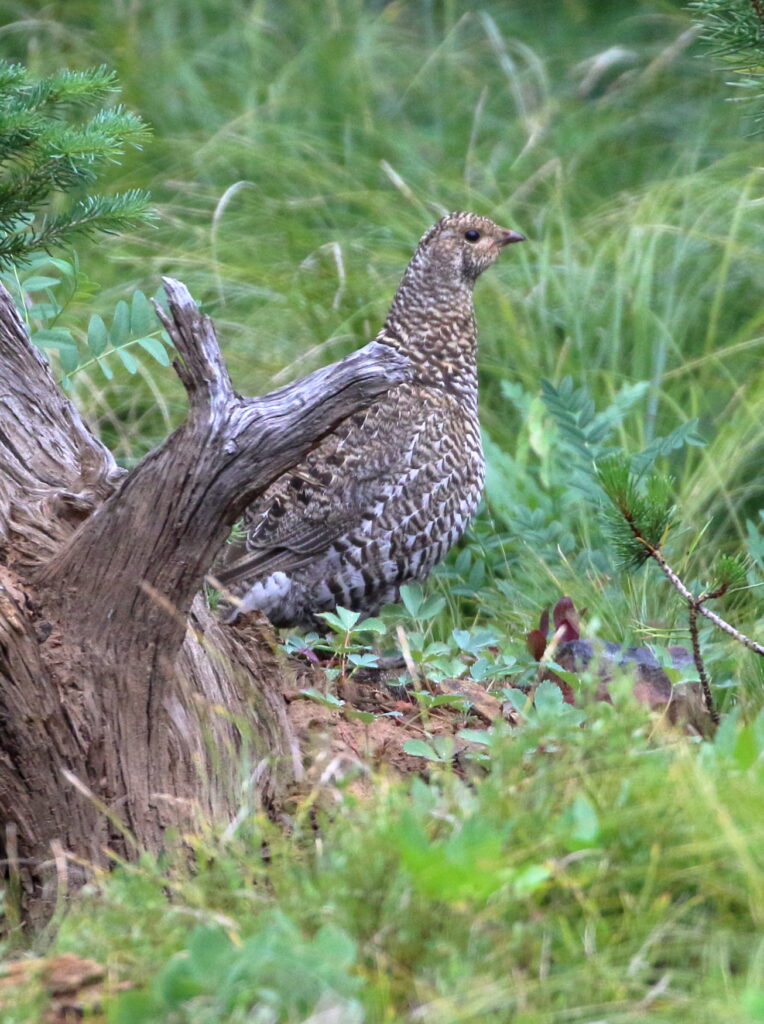
“We did it!” I affirmed. “We found a Spruce Grouse!” Neither of us could quite believe it. Even better, we spotted two babies popping their heads up and down right behind mom.
We continued up the road for another ten minutes, hoping to glimpse a male, but didn’t see one, so turned around and began bumping back toward the main road. We were not finished with this promising area, though. At another burn area, I pulled over. “Let’s just walk up the slope a bit,” I suggested, grabbing my camera and binoculars. We did, scanning the forest of dead tree trunks for any sign of woodpeckers. Then, we heard drumming to our right and our eyes locked.
“Let’s go over there,” Braden said, and we began picking our way over fallen logs and slash, and through fresh, thriving young trees and shrubs. As we walked, the drumming sound was replaced by tapping, and we grew closer and closer until we felt sure it was coming from a tall tree right in front of us.
“Do you see it?” I asked peering hard at the trunk against a backlit sky. Braden shook his head, so I circled around the tree, trying to spot it from different angles. Finally, I saw movement down low behind a green branch of a living tree. “I got it,” I called to Braden.
It took some time to get a clear look at it, and the first thing I saw was a lot of white showing on its back. This led the pessimistic side of me to conclude it was a Hairy Woodpecker. After all, no yellow showed on its head—the clear sign of a male Three-toed or Black-backed. As Braden also got his eyes on it, though, we began going through its other features. Most prominent? Black barring on its breast.
“Do Hairys have those black markings?” I asked, quickly consulting Sibley. “They don’t!”
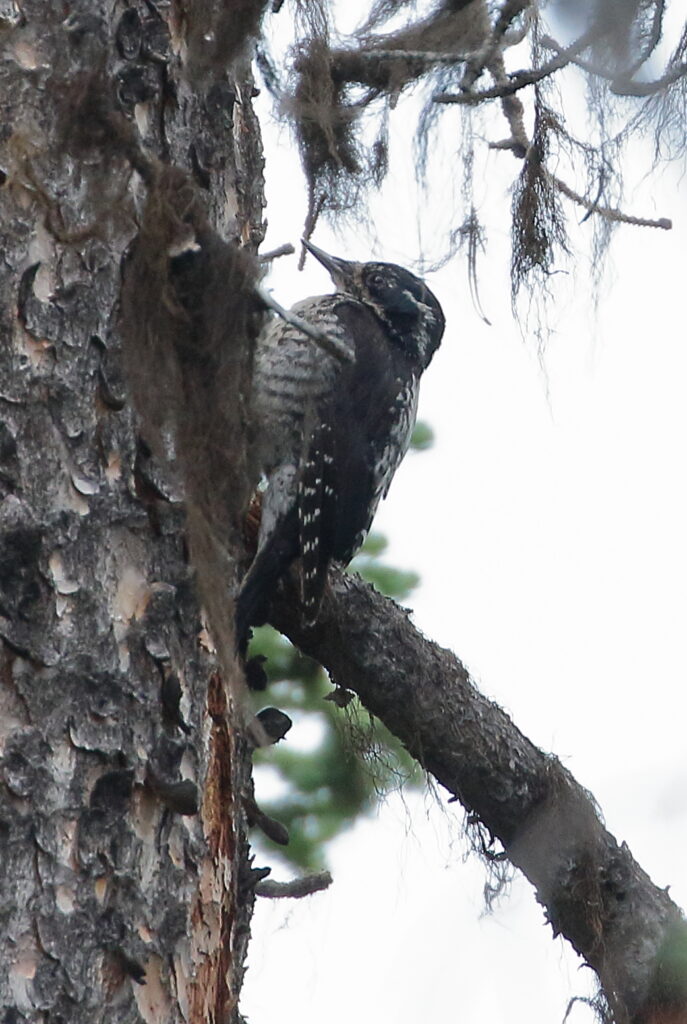
“It’s a Three-toed!” Braden agreed.
Wow. On this one day we had set aside to bird at elevation, we had found almost all of the birds we longed for, missing only a Black-backed Woodpecker.
We weren’t as successful with shorebirds, but that didn’t surprise us. Making our way over to Warm Springs, we found a nice group of Long-billed Dowitchers, and Greater and Lesser Yellowlegs, but not the Baird’s or Pectoral Sandpipers or small “peeps” (Least, Semipalmated, or Western Sandpipers) we were hoping for. Still, we did discover a surprise Black-crowned Night-Heron at the main Warm Springs ponds—something totally off our radar. In fact, I had started the day hoping for maybe one or two Year Birds, and ended up with six! Our success was only dampened by the knowledge that it might be our last big day of birding together this summer. Still, that is the yin and yang of birding—and of life. You just gotta enjoy it all.
Our grouse eBird checklist: https://ebird.org/checklist/S190227269

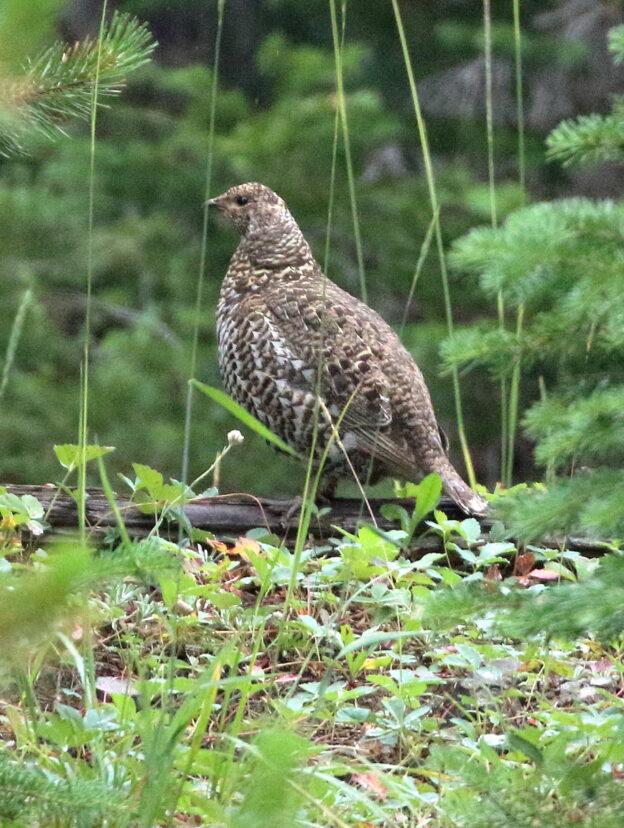
Exciting story and the photos are wonderful! Glad you found what you were looking for. Can’t believe Braden’s last year!
Thank you, Marie! Hope you’re seeing some nice birds these days. Fall migration is almost here!
Sounds like a great outing and a fitting summer birding finale for the Dynamic Duo of Montana Birding. Love those bighorn sheep! Or are they Horned Larks? I can’t tell. 🤓
Congrats on the Spruce Grouse success. And chicks too, awesome!
There have been recent rare bird alerts for Dusky Grouse in my neck of the woods l, but I haven’t had the time or inclination to mount an expedition. Which probably explains why I’ve never seen a grouse, lol. Someday my grouse prince will come.
Yes, those are Horned Larks (ha!). Just saw a Dusky Grouse today–its head peeking up over some tall, dry grass. Guessing it had some young ‘uns nearby. You’ll see one soon, I’ll bet!
I always learn a lot from these entries. For instance, that burned out areas are primo bird watching regions.
Thanks, Bill! It would be fun to take you birding there sometime!
Thanks Roger for the comment about the big horn sheep. I thought I should make one but I had nothing of value. I will think of you when Sneed visits the North Bay in September, when he will no doubt pepper me mercilessly with snarky comments and Dad jokes, many of which I’d like to smile at but can only elevate my emotions into a grimace. I will also think of you for moral support when I try to open his horizons to fine ales, taking him on side stops to Russian River Brewing (home of internationally famous Pliny the Elder and Younger IPAs for those of you readers not familiar with brewery royalty like Roger) and our local family favorite, Olde Sonoma Publick House, and again when I try to suggest that food should be tasted for aesthetic quality and not merely swallowed for maintaining energy during birding trips. Regardless of my success or failure, we shall certainly toast you.
My jokes are NOT “Dad jokes.” They are based on witty, high-quality, sophisticated observations about this enigmatic world around us.
Food = fuel for birding.